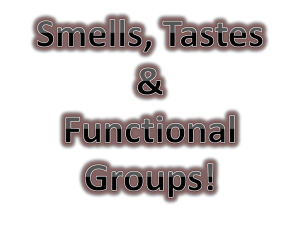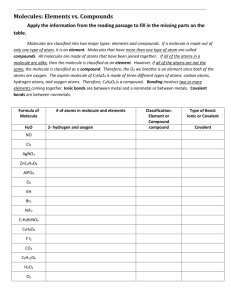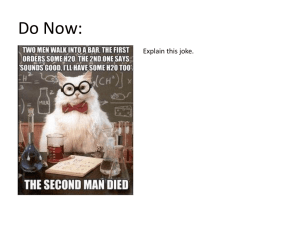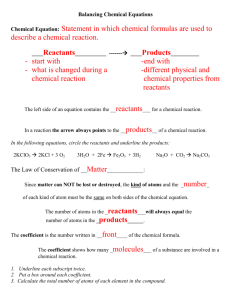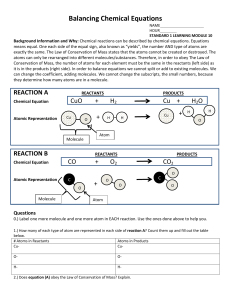answer key
advertisement
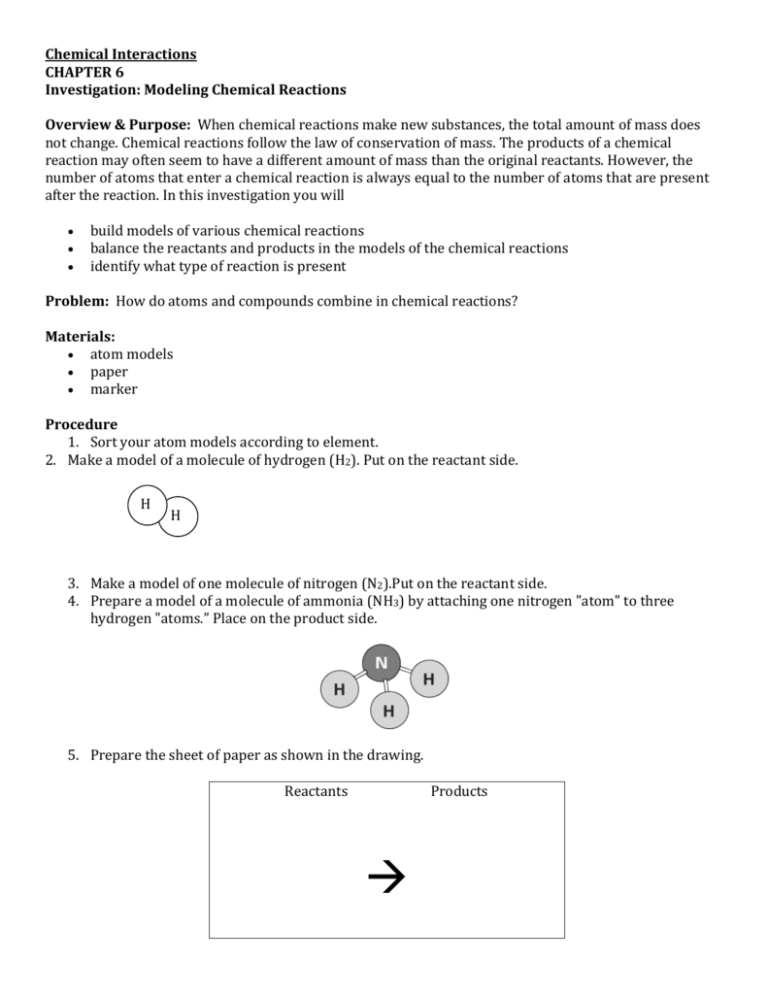
Chemical Interactions CHAPTER 6 Investigation: Modeling Chemical Reactions Overview & Purpose: When chemical reactions make new substances, the total amount of mass does not change. Chemical reactions follow the law of conservation of mass. The products of a chemical reaction may often seem to have a different amount of mass than the original reactants. However, the number of atoms that enter a chemical reaction is always equal to the number of atoms that are present after the reaction. In this investigation you will build models of various chemical reactions balance the reactants and products in the models of the chemical reactions identify what type of reaction is present Problem: How do atoms and compounds combine in chemical reactions? Materials: atom models paper marker Procedure 1. Sort your atom models according to element. 2. Make a model of a molecule of hydrogen (H2). Put on the reactant side. H H 3. Make a model of one molecule of nitrogen (N2).Put on the reactant side. 4. Prepare a model of a molecule of ammonia (NH3) by attaching one nitrogen "atom" to three hydrogen "atoms.” Place on the product side. 5. Prepare the sheet of paper as shown in the drawing. Reactants Products 6. Place one molecule of hydrogen (H2) and one molecule of nitrogen (N2) on the Reactants side of the paper. Place an ammonia (NH3) molecule on the Products side of the paper. Nitrogen combines with hydrogen to form ammonia. 7. In Table 1, write the chemical equation that represents the molecules you have arranged. 8. Make a model of an oxygen (O2) molecule and a H(H2) molecule. Put on the reactant side. 9. Make two water (H2O) molecules. Place on the product side. 10. Count and balance so that both sides are equal. 11. Write the formula on the data chart letter B. 12. Repeat the procedure for the following reactions. In each case, make enough molecules so that you can balance the equation you are modeling. Reactant side Product Side c. sodium (Na) + chlorine (Cl2) → sodium chloride (NaCl) d. aluminum fluoride (AlF3) → aluminum (Al) + fluorine (F2) e. aluminum oxide (Al2O3) → aluminum (Al) + oxygen (O2) 13. Answer the “Observe and Analyze” and “Conclude” questions on your lab report. Chemical Interactions Name: Investigation: Modeling Chemical Reactions Period: # Data: Balanced Chemical Equations A Drawing Formula: B Drawing Formula: C Drawing Formula: D Drawing Formula: E Drawing Formula: Observe and Analyze 1. Interpret Suppose all of the model atoms you made had exactly the same mass. How would the total mass of the reactants compare to the total mass of the products in all of the equations? Why? 2. Identify what type of reaction (synthesis, decomposition, single or double replacement) each of the formulas in the chart above is. A. B. C. D. E. 3. Analyze Data Write the formulas for water, a hydrogen molecule, and an oxygen molecule. Write the balanced equation for the decomposition reaction in which water breaks apart into hydrogen and oxygen. CONCLUDE 4. Compare and Contrast What is the difference between 2O and O2? In what way are they similar? 5. Infer What important facts about a chemical reaction does a chemical equation provide? 6. Apply When iron rusts, the reaction can be written 4Fe + 3O2 → 2Fe2O3. How would you expect the mass of the rust (Fe2O3) to compare to the mass of the iron itself?(greater than, less than, equal to) What other information would you have to know to calculate the mass of the rust produced? 7. Analyze How well did this activity help you with balancing equations? Explain the benefits and limitations of this lab. ANSWER KEY Hypothesis Sample answer: If I add two molecules of hydrogen to the reactants and one molecule of ammonia to the products, then the reaction will be balanced, because the same number of atoms of each element will be on both sides of the equation. Observe and Analyze 1. 1. N2 + 3H2 →2NH3; 2. 2H2 + O2 →2H2O; 3. 2Na + Cl2→ 2 NaCl; 4. 2AlF3 →2Al + 3F2; 5. CH4 + 2O2 →CO2 + 2H2O 1. The total mass would be the same on both sides of the equation 2. a synthesis b. syntheisi c. syntheisi, d. decomposition, e. single replacement 3. 2H2O→ 2H2 + O2 4. 2O stands for two separate atoms of oxygen. O2, stands for two oxygen atoms combined into a molecule of oxygen. They both refer to two atoms of oxygen.The equation is the reverse reaction to number 2. Conclude 5. If the hypothesis contained the correct number of molecules to balance the equation, then the hypothesis A chemical reaction tells what the reactants are, what the products are, how many molecules of each substance take part in the reaction, and the direction of the reaction would be supported. 7. The rust would have a greater mass because it combined with oxygen. You would have to know the mass of the oxygen.



